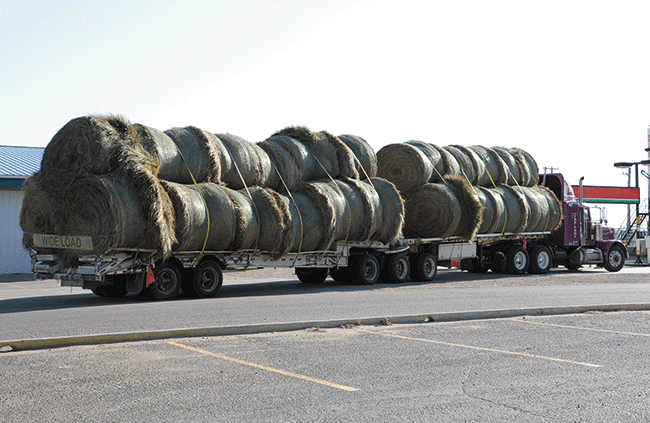Drought disasters declared by two southwest RMs
Posted on July 28, 2015 by Maple Creek A semi hauling hay bales fuels up at the Co-op on Friday morning. Drought conditions in many parts of the Southwest are causing a feed shortage, forcing producers to buy hay from other regions. The RMs of Maple Creek and Piapot are the first in the province to declare states of agricultural disaster due to the lack of rain. Photo by Marcia Love
A semi hauling hay bales fuels up at the Co-op on Friday morning. Drought conditions in many parts of the Southwest are causing a feed shortage, forcing producers to buy hay from other regions. The RMs of Maple Creek and Piapot are the first in the province to declare states of agricultural disaster due to the lack of rain. Photo by Marcia LoveBy Marcia Love
As drought conditions continue, the RMs of Maple Creek and Piapot are both declaring a “state of agricultural disaster.”
The hot, dry weather and extreme lack of rain resulted in the two rural municipalities making the declaration to allow access to provincial or federal relief programs if they become available.
“You see places where there have been some timely rains and other areas that just aren’t getting them. A few kilometres can make all the difference,” said RM of Piapot Reeve John Wagner. “We looked at the RM as a whole, and the majority of the RM is in a scenario where we’re not getting the rainfall and we don’t have the pasture life or the hay crops or grain crops coming that we normally do.”
Council hopes the designation will assist in offsetting the cost of trucking should the government step in with a program – such as Hay West in 2002.
Within the RM of Piapot, some producers are reporting the worst crop in 40 years, with hay crops that are 25 per cent or less of last year.
“The germination just is not there,” Wagner said.
While his area normally gets nine to 10 inches of rain by this time of year, the reeve noted it hasn’t even amounted to four inches this year.
“Here we haven’t had over a half inch of rain (at one time) yet,” he said.
Prior to yesterday’s rain, Maple Creek only received 10 millimetres of precipitation this month. It typically sees about 46 mm by the end of July.
The two local RMs are currently the only ones who have made the declaration, which they have sent notice of to the Saskatchewan Association of Rural Municipalities (SARM).
In Alberta, Cypress County made a similar declaration last week, as well as other counties throughout the province.
Last Thursday, the federal government announced Western livestock producers will be receiving tax relief as a result of the drought.
Hundreds of municipalities, divisions and counties across B.C., Alberta and Saskatchewan, as well as several in Manitoba, are eligible for the 2015 livestock tax deferral provision. Livestock producers in these “prescribed drought regions” facing feed shortages can defer a portion of their 2015 sale proceeds of breeding livestock for one year in order to help replenish their stock the following year. To defer income, the breeding herd must have been reduced by at least 15 per cent.
Producers facing cash-flow challenges can apply to the federal Advance Payments Program to access low-interest loans of up to $400,000. The interest on the first $100,000 is paid by the federal government.
A couple days prior to the federal government’s announcement, the Saskatchewan Stock Growers Association (SSGA) asked Ottawa for tax deferrals for those dealing with the dry conditions.
SSGA president Doug Gillespie said livestock producers in several areas of the province are reporting hay yields that are 50-70 per cent below normal as well as poor growth on pastures, meaning many producers could be forced to sell portions of their breeding herds.
“While recent rains will improve pasture conditions in some areas, it is too late for many hay crops as well as any producers forced to sell due to poor pasture growth earlier in the season,” he stated.
According to the province’s crop report for July 14-20, just over half the hay crop has been baled or put into silage. Only two per cent of the hay crop is rated excellent, with another 52 per cent good, 38 per cent fair and eight per cent poor. Hay yields on dry land are well below the five year average (2010-2014), with the average estimated to be 0.8 tons per acre for alfalfa, 0.9 tons per acre for alfalfa/brome hay, 0.7 tons per acre for both other tame hay and wild hay, and 1.3 tons per acre for greenfeed.


Leave a Reply
You must be logged in to post a comment.